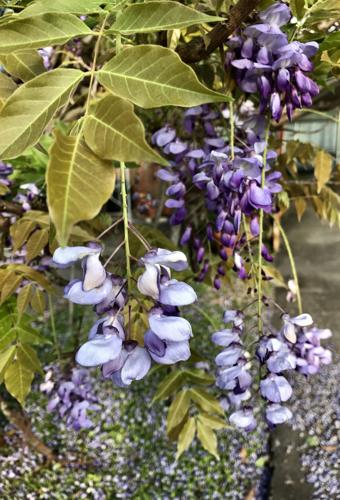If you've been caught up in the hysteria against Chinese wisteria, you are not alone.
This plant, prized for hundreds of years, is no longer “in.” The reasons are obvious: Left to its own devices, wisteria will scramble over any trellis, climb high into trees, twist iron like King Kong, destroy roofs and pull down wooden railings. Its sins, it seems, are too many to list.
But if an early spring breeze has ever brought you the blossoms' fragrance, or if you've been stunned by the blanket of purple and lavender on a carport roof, you have seen wisteria for what it is: a gorgeous vine with which you’ll have to develop a close relationship if you want to get along.
I'm lucky: I was born with a wisteria vine growing in my yard. I asked my mother about it once, and she said it was there when she and my father bought the house in 1944. That means that for a minimum of 74 years, it has been following its annual cycle: blooming on bare wood in February or March, leafing out, then growing demonically for the next six months. Chinese wisteria is deciduous, so come autumn its leaves begin to yellow, and by Christmas they are all gone. For a couple of months the plant looks dead: nothing but a pile of sticks, the base contorted into odd shapes. Then the rebirth begins again.
Not long ago, my dog Poppy and I were walking around the block when I caught the unmistakable scent of wisteria on the breeze. I looked around and realized it was coming from my neighbor’s house, a block away.
Hilary Irvin has carried on a tempestuous relationship with her wisteria vine for decades.
“It was here when I moved in 47 years ago, along with two sweet olive trees, all those wonderful day lilies and a group of ‘pop up’ seasonal bulbs scattered here and there. I think they all date from the construction of the house, circa 1904,” she said. “I do nothing to any of them as far as fertilizer goes, yet they’re all still with us.”
Irvin does not fancy herself a gardener and outright scoffed when I asked her how she had “trained” her wisteria into a tree form. Yet that is what it looks like to me, so that when it is in full bloom, blossoms cascade as if it were a weeping willow. It doesn’t just smell heavenly, it’s a sight to behold.
At first the flowers look like baby corn; then they grow longer and more shapely, somewhat like a cluster of grapes. The more they open, the paler they become, so that blossoms in a variety of shades of purple and lavender are present at the same time. Eventually they cascade to the ground, forming a carpet of petals.
Irvin thinks the rusted and mangled garden arch that is inextricably intertwined with the wisteria is proof of the vine’s age and also testament to the folly of the poor soul who planted it and didn’t understand its might.
“When I moved in, a neighbor who had lived here from birth told me that I had to get rid of ‘that thing,’” Irvin said.
His admonition may not have been entirely unwarranted. It is true, according to Irvin, that the rampantly growing vine creates a menace in the summer when it seems to grow a foot a day. If not controlled somewhat heartlessly, it will leap atop Irvin’s carport and clamber toward the neighbor’s property, coiling around anything and everything in its path.
“Since it is next to my driveway, I usually have wisteria leaves and branches trapped in my car windows and doors, and in my clothes all summer,” Irvin said. “I just hack away at it as much as I have energy to do in the heat. Over the winter, it behaves.”
Living with Chinese wisteria (there are other kinds, including a native, that are far less demanding) isn’t for everyone. Although Irvin said she admires its persistence and resilience, she has indeed considered following the neighbor’s advice and getting rid of it.
“Just when you think it’s time to say bye-bye, you see those little buds popping out, and immediately afterward, a magnificent display,” she said.
Being a woman of a certain age, I too admire the vine’s persistence and resilience. So when Irvin delivered her final reflection on the plant, I considered it carefully.
“Its trunk looks termite-eaten and rotten, but it just keeps going,” she said. “Bless its heart.”



